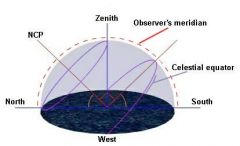![]()
![]()
![]()
Use LEFT and RIGHT arrow keys to navigate between flashcards;
Use UP and DOWN arrow keys to flip the card;
H to show hint;
A reads text to speech;
32 Cards in this Set
- Front
- Back
|
Rotation( Motion of the earth)
|
Cause of day/night. Half surface facing the sun is illuminated. Entire surface rotates through sunlight each day. From WEST to EAST which causes objects to rise in EAST and set in the WEST
|
|
|
Orbital Motion (motion of the earth)
|
seasonal variation of constellations
|
|
|
Seasons (motion of the earth)
|
rotational axis tilted at 23.5 degrees to ecliptic.
|
|
|
orbital motion (motion of the moon)
|
in eastward direction around earth with angular speed of 1/2 degree per hour
|
|
|
Lunar Phases (motion of the moon- Orbital motion)
|
like earth, half of surface is illuminated; as moon orbits earth earth-based viewers see different fraction of illuminated surface.
|
|
|
Lunar Phases in Order
|
new, crescent waxing, half-moon waxing, gibbous waxing, full, gibbous waning, half-moon waning, crescent waning
|
|
|
Rotation (Motion of the moon)
|
the moon rotates once per orbit about the earth: SYNCHRONOUS ROTATION. Always see the same face of moon from earth.
|
|
|
celestial equator
|
the projection of the earth's equator on the sky
|
|
|
polaris
|
marks the position of the earth's rotation axis. Appears fixed in the sky.
|
|
|
Big Dipper
|
located in Ursa Minor. Can be used to find the little dipper which contains the north star (polaris)
|
|
|
observer's meridian
|

a meridian that passes through the observer's zenith
|
|
|
zenith
|
the top of the sky above your head.
|
|
|
rotational axis of earth tilted at ____ to ecliptic
|
23.5
|
|
|
eclipses
|
caused by shadow of earth and moon. Partial, total and annular.
|
|
|
umbra
|
the innermost and darkest part of a shadow, where the light source is completely blocked by the occluding body. An observer in the umbra experiences a total eclipse.
|
|
|
penumbra
|
the region in which only a portion of the light source is obscured by the occluding body. An observer in the penumbra experiences a partial eclipse
|
|
|
pro-grade motion
|
motion in the same direction as the stars
|
|
|
retro-grade motion
|
motion opposite to the background stars
|
|
|
All planets orbit __________ around the sun in slightly ecliptic orbits
|
eastward with Sun not at center, but a one focus (Kepler's first)
|
|
|
the farther a planet from the sun, the more _________ it moves
|
slowly. the speed
varies in a systematic, predictable way. (Keplers 2nd) |
|
|
The further from the Sun, the slower the _______ speed of the planet and
the longer the “year” |
angular. Kelper's 3rd. p^2 =a^3
|
|
|
Law of gravity
|
gravitational force between two objects is proportional to
the product of the mass of each object divided by the distance between their centers squared. |
|
|
orbital motion =
|
free fall.
|
|
|
Orbital Resonances
|
– Small objects orbiting larger objects: tidal interactions create relationships between rotation
rate and orbital period (spin-orbit coupling or resonance). – Small objects orbiting inside orbit of larger objects: relationships between orbital periods create gaps or divisions. |
|
|
Escape Speed
|
speed required to escape the gravity of an object = (2GM/r)1/2
• where M = mass of central object, r = distance from object’s center. |
|
|
age of the solar system
|
4.6 billion years old
|
|
|
Order of Planets from the Sun
|
mercury, venus, earth, mars, jupiter, saturn, uranus, neptune
|
|
|
terrestrial Planets
|
mercury, earth, venus, mars. "all composed mostly of rock and heavy metals. These planets have a core made of heavy metals that is mostly iron; the core is surrounded by a mantle of silicate rock. Terrestrial planets are much smaller than gas giants. The terrestrial planets also have varied terrain such as volcanoes, canyons, mountains, and craters. Another common feature among the terrestrial planets is that they have few or no moons"- universetoday.com
|
|
|
jovian planets
|
jupiter, saturn, uranus, neptune. Gas Giants. Large, have several moons. Rocky or liquid core somewhere in the center of the gas.
|
|
|
comet
|
a celestial body moving about the sun, usually in a highly eccentric orbit, consisting of a central mass surrounded by an envelope of dust and gas that may form a tail that streams away from the sun.
|
|
|
asteroid
|
Any of numerous small, often irregularly shaped rocky bodies that orbit the Sun primarily in the asteroid belt , a region between the orbits of Mars and Jupiter.
|
|
|
meteoroids
|
any of the small bodies, often remnants of comets, traveling through space: when such a body enters the earth's atmosphere it is heated to luminosity and becomes a meteor.
|

